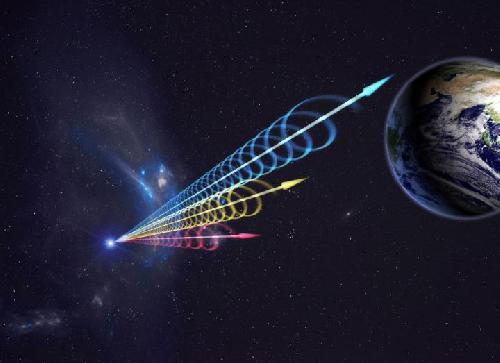Fast Radio Bursts - bursts of energy from space that appear as a short flashes of radio waves to telescopes on Earth - have baffled astronomers since first detected a decade ago.
Though only 16 have been recorded, there could be thousands of of these mysterious events each day.
At least one may be a little closer to being better known, thanks to analysis of data recorded during radio astronomy observations. The origin of a newly discovered Fast Radio Burst may be tied to a highly magnetized, gas-filled region of space, providing a new hint in the decade-long quest to explain the mysterious radio pulses. The burst, dubbed FRB 110523, originated no more than six billion light-years from Earth. As they sifted through the detailed data, the researchers discovered that the FRB exhibited Faraday rotation, a corkscrew-like twist radio waves acquire by passing through a powerful magnetic field.

Additional analysis of the signal revealed that it also passed through two distinct regions of ionized gas, called screens, on its way to Earth. By using the interplay between the two screens, the astronomers were able to determine their relative locations. The strongest screen is very near the burst's source -- within a hundred thousand light-years -- placing it inside the source's galaxy. Only two things could leave such an imprint on the signal: a nebula surrounding the source or a galactic center.
"We now know that the energy from this particular burst passed through a dense magnetized field shortly after it formed," says Kiyoshi Masui, an astronomer with the University of British Columbia in Canada and lead author of the new paper about it in Nature. "This significantly narrows down the source's environment and type of event that triggered the burst--and means the source of the pulse likely resides within a star-forming nebula or the remnant of a supernova."
"Hidden within an incredibly massive dataset, we found a very peculiar signal that matched all the known characterizes of a Fast Radio Burst, but with a tantalizing extra element that we simply have never seen before," said Jeffrey Peterson, a faculty member with Carnegie Mellon and author on the paper.
"Taken together, these remarkable data reveal more about an FRB than we have ever seen before and give us important constraints on these mysterious events," says Masui. "We also have an exciting new tool to search through otherwise overwhelming archival data to uncover more examples and get closer to truly understanding their nature."





Comments